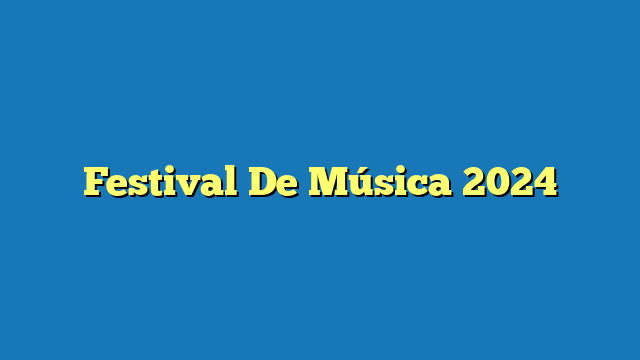## Festival de Música: A Cultural Extravaganza
### Introduction
Music festivals, celebrated around the globe, are vibrant events that bring together people from all walks of life to share in the common language of rhythm, melody, and expression. These ephemeral gatherings transcend the boundaries of geographical and cultural divides, fostering a sense of unity and belonging among attendees.
### History and Evolution
The origins of music festivals can be traced back to ancient times, with gatherings where music played an integral role in religious rituals and community celebrations. In the 20th century, music festivals emerged as a distinct cultural phenomenon, influenced by the rise of popular music and the counterculture movement.
The Woodstock Festival of 1969 stands as a pivotal moment in the history of music festivals, marking a shift towards large-scale events with a focus on peace, love, and social consciousness. Subsequent festivals, such as Glastonbury and Coachella, have continued to push the boundaries of musical diversity and experiential offerings.
### Types of Music Festivals
Music festivals encompass a wide range of genres and subgenres, catering to diverse musical tastes and preferences. Some of the most common types include:
– Rock and metal festivals: These events showcase a variety of rock and metal bands, from classic acts to emerging artists.
– Pop music festivals: These festivals feature popular music artists from across the musical spectrum, including pop, hip-hop, and electronic dance music (EDM).
– Folk and acoustic festivals: These events focus on folk music, bluegrass, and other acoustic genres, often emphasizing traditional instruments and storytelling.
– Electronic music festivals: These festivals showcase renowned DJs and producers from the world of EDM, techno, house, and other electronic subgenres.
– World music festivals: These events celebrate the rich diversity of music from around the globe, bringing together traditional and contemporary artists from various cultures.
### Global Impact
Music festivals have become a global phenomenon, with events taking place in every corner of the world. They serve as important platforms for cultural exchange, promoting understanding and appreciation of different musical traditions. Additionally, festivals contribute significantly to the local economy, generating revenue for businesses and creating employment opportunities.
### Beyond Music
While music remains the central focus of these events, many festivals also incorporate additional elements to enhance the attendee experience. These can include:
– Art installations: Festivals often feature immersive and interactive art installations that complement the musical performances.
– Food and beverages: A diverse array of food and beverage options are typically available at festivals, providing a culinary feast alongside the musical entertainment.
– Workshops and educational programs: Some festivals offer workshops, masterclasses, and educational programs, allowing attendees to learn from industry experts and expand their musical horizons.
– Camping and glamping: Many festivals offer camping or glamping options, creating a sense of community and extending the festival experience beyond the main performances.
### Social and Cultural Significance
Music festivals have a profound social and cultural impact, fostering a sense of belonging and shared experience among attendees. They provide a space for self-expression, creativity, and connection, breaking down barriers and building bridges between people of different backgrounds.
Additionally, festivals often raise awareness of social and environmental issues, serving as a platform for activism and positive change.
### Conclusion
Music festivals are vibrant cultural events that have become an integral part of our globalized world. They celebrate the power of music to unite, inspire, and transcend boundaries. By embracing diversity, fostering creativity, and promoting social engagement, music festivals continue to enrich our lives and shape our cultural landscape.



